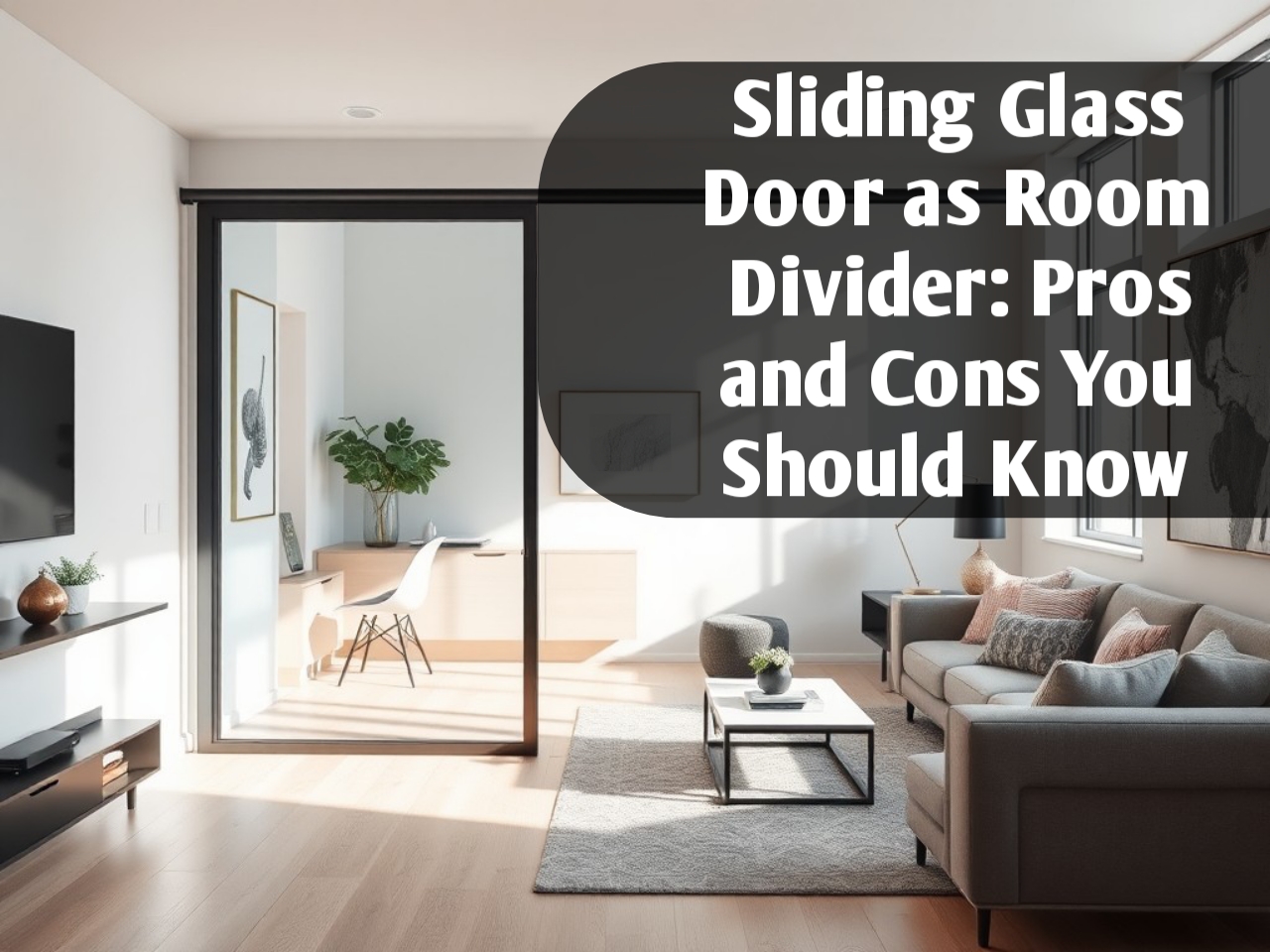Sliding Glass Door as Room Divider: Pros and Cons You Should Know
Using sliding glass doors as room dividers has become an increasingly popular design trend in modern homes. This innovative solution combines aesthetics and functionality, providing homeowners with a way to create separate spaces without sacrificing natural light or openness. However, as with any design choice, there are advantages and disadvantages to consider. In this article, we’ll explore sliding glass door as room divider pros and cons, helping you decide if it’s the right option for your home.
What Are Sliding Glass Door Room Dividers?
Sliding glass doors are most commonly associated with exterior entrances, often leading to patios or balconies. However, in recent years, these doors have been repurposed for indoor use as room dividers. Instead of solid walls, homeowners can use sliding glass doors to separate rooms while maintaining an open, airy feeling.
The doors are typically mounted on tracks and glide smoothly to open or close the space. This flexibility is particularly useful in open-plan living areas where you may want to create distinct zones without the permanence of a traditional wall. Sliding glass doors as room dividers offer a modern, stylish solution for partitioning spaces in a way that remains flexible and visually appealing.
The Pros of Using Sliding Glass Doors as Room Dividers
1. Maximizing Natural Light
One of the most significant benefits of using sliding glass doors as room dividers is the ability to let light pass through. Unlike traditional walls or opaque dividers, glass allows natural light to flood both spaces, creating a bright, inviting atmosphere. In homes with limited windows or smaller spaces, maintaining access to daylight is crucial. Sliding glass doors provide a way to divide rooms without making either space feel dark or cramped.
By maximizing natural light, sliding glass doors can reduce the need for artificial lighting during the day, contributing to energy savings. They also help small rooms feel larger and more open, which is particularly important in urban apartments or homes with limited square footage.
2. Creating Flexible, Multi-Functional Spaces
Sliding glass doors offer a level of flexibility that traditional walls simply can’t match. You can easily open or close the doors depending on your needs, allowing you to create an open-plan space when desired or section off areas for privacy. This is especially useful in homes with open layouts, where dividing spaces for different purposes—such as a dining area, living room, or home office—may be necessary.
For instance, you can close the doors to create a private office space during work hours, then slide them open to merge the area with the rest of the home when it’s time to relax or entertain guests. This adaptability makes sliding glass doors an excellent choice for people who need their living spaces to be multi-functional.
3. A Modern and Stylish Design Element
Sliding glass doors as room dividers add a sleek, modern aesthetic to any home. Glass, with its clean lines and reflective qualities, fits well in contemporary interiors where simplicity and minimalism are key design elements. Additionally, sliding glass doors can be customized with different finishes, frame materials, and glass types, making them a versatile option for various styles.
Whether you prefer a minimalist, industrial look with metal frames, or a warmer, more traditional aesthetic with wood accents, sliding glass doors can be tailored to complement your existing decor. Frosted or textured glass can be used for added privacy, while clear glass creates an uninterrupted visual flow between rooms.
4. Enhanced Sense of Space and Openness
Sliding glass doors maintain the visual connection between two rooms, which helps retain an open and expansive feel. In small homes or apartments, this sense of openness can make a significant difference in how large and comfortable the space feels. Unlike solid walls that close off areas and interrupt the flow of a home, glass doors keep sightlines intact, making both rooms appear larger.
This design strategy works especially well in homes with smaller living areas. A sliding glass door allows you to partition a room when needed without making the space feel compartmentalized or confined. In larger homes, the doors can provide subtle separation between expansive areas while still maintaining an open layout.
5. Easy Maintenance and Durability
Glass doors are relatively easy to clean and maintain. Unlike walls that may require repainting or refinishing, glass only needs regular cleaning to keep it looking its best. With high-quality materials, the hardware on sliding doors—such as tracks and handles—can be durable and long-lasting, reducing the need for frequent repairs.
Glass itself is highly resistant to wear and tear, although the frame materials—whether wood, aluminum, or steel—may need occasional maintenance depending on environmental factors and usage. By opting for quality finishes, homeowners can ensure that their sliding glass doors remain functional and aesthetically pleasing for years to come.
The Cons of Using Sliding Glass Doors as Room Dividers
1. Limited Sound Insulation
One of the most significant drawbacks of using sliding glass doors as room dividers is the lack of sound insulation. Glass, even if thick, is not as effective at blocking sound as a solid wall. This can be an issue in homes where noise control is a priority, such as in open-plan living rooms that are adjacent to bedrooms or home offices. While some sliding glass doors come with soundproofing features, they may not offer the same level of noise reduction as a traditional wall.
For homes with children, pets, or loud environments, this lack of sound insulation can be a disadvantage. In these cases, opting for frosted or laminated glass, which may offer better soundproofing, could be a more practical solution.
2. Potential Privacy Concerns
While sliding glass doors are excellent for creating visual openness, they may not provide the level of privacy that some homeowners desire. Clear glass allows for unobstructed views between rooms, which can be a disadvantage in spaces like bedrooms, bathrooms, or home offices where privacy is essential.
To mitigate this issue, homeowners can opt for frosted or textured glass, which provides more privacy while still allowing light to pass through. Additionally, curtains, blinds, or other window treatments can be installed to offer privacy when needed. However, these solutions may detract from the sleek, minimalist aesthetic that makes sliding glass doors so appealing.
3. Thermal Insulation Challenges
Glass is not as thermally efficient as other materials like insulated walls or doors. Using sliding glass doors as room dividers could potentially result in heat transfer between rooms, making it more challenging to maintain consistent temperatures in separate spaces. This issue is particularly relevant in homes with varying heating or cooling needs between different rooms.
While some sliding glass doors come with energy-efficient features, such as double or triple glazing, they may still not offer the same level of thermal insulation as a solid wall. Homeowners should weigh this potential downside if temperature control is a critical concern.
4. Cost of Installation and Customization
Installing sliding glass doors as room dividers can be more expensive than other partition options, particularly if you require custom sizes, high-end materials, or additional features such as soundproofing or frosted glass. The cost of installation also includes labor, and depending on the complexity of the project, the price can quickly add up.
In addition to the initial cost, maintenance and repairs over time may also incur expenses, particularly if the door’s hardware—such as tracks and rollers—needs replacement. However, investing in quality materials and professional installation can minimize the need for future repairs and extend the lifespan of the doors.
5. Risk of Breakage
Although glass is generally a durable material, there is always a risk of breakage, especially in homes with children or pets. Even tempered or laminated glass, which is designed to be safer in case of breakage, still presents the potential for accidents.
While modern safety glass significantly reduces the risk of injury in the event of a break, it’s still a consideration for families or anyone concerned about the fragility of glass doors. Regular inspections of the door’s condition and ensuring that the glass meets safety standards can help mitigate this risk.
When Are Sliding Glass Door Room Dividers the Best Option?
Sliding glass doors are ideal for homes that prioritize open, light-filled spaces and flexible layouts. They work particularly well in modern or contemporary interiors where clean lines and minimalist designs are favored. For homeowners who want to maintain visual connectivity between rooms while still having the option to close off spaces when needed, sliding glass doors offer a perfect solution.
Additionally, these doors are an excellent choice for smaller homes or apartments where maximizing space and light is essential. However, if privacy, sound insulation, or thermal control are your top priorities, it’s important to consider whether sliding glass doors can meet those needs adequately.
Design Tips for Sliding Glass Door Room Dividers
To get the most out of sliding glass doors as room dividers, consider the following design tips:
- Frame materials: Choose a frame material that complements your home’s decor. Aluminum, wood, and steel are popular choices, each offering a different aesthetic.
- Glass type: Consider frosted, tinted, or textured glass for areas where privacy is important.
- Hardware quality: Invest in high-quality tracks and rollers to ensure smooth operation and longevity.
- Maintenance: Regularly clean and inspect your sliding glass doors to keep them looking and functioning their best.
Conclusion: Weighing the Pros and Cons
Sliding glass doors as room dividers offer a stylish, modern, and functional way to partition spaces without sacrificing light or openness. However, they do come with certain trade-offs, including limited privacy and sound insulation. By carefully considering these pros and cons, you can determine whether sliding glass doors are the right solution for your home. Whether you’re aiming to create flexible, multi-functional spaces or simply want to add a sleek design element, sliding glass doors provide a versatile and visually appealing option for modern interiors.
Read Also Our This Post: Exploring The Edison Interior Drawings: A Glimpse Into Timeless Design



